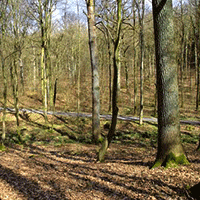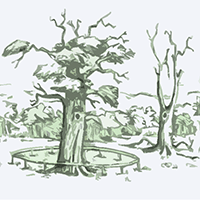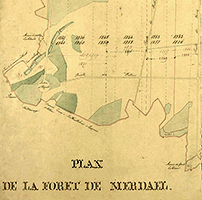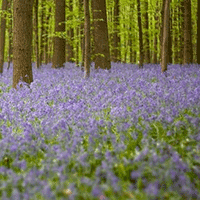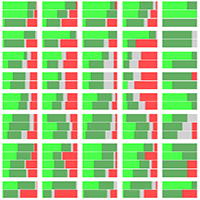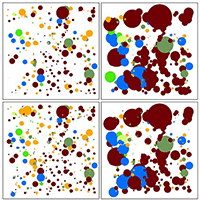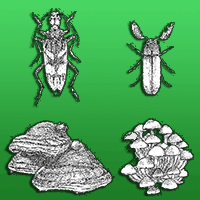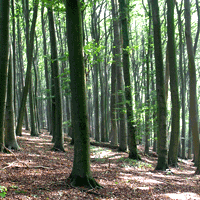For many centuries, coppice-with-standards management was applied in the mixed oak stands of Meerdaal forest (Belgium). Over the last century, these stands were gradually converted to high forest. On an area of 20 ha, the coppice-with-standards management is being restored, with specific adaptations for biodiversity (conservation of dead wood and veteran trees). A survey of saproxylic beetles was performed at 8 locations in the forest, including one site within the coppice-with-standards restoration. This survey not only allowed an evaluation of the saproxylic beetle richness of the forest complex, but also made exploratory observations on the effect of this type of management, as compared to non-intervention, on species richness and composition of saproxylic beetles. The results show that the overall species richness in the forest complex was quite high and comparable to forest reserves in Germany. Both coppice-with-standards and high forest options appear to be equally species-rich, but consist of different communities, both containing specific, rare and notable species, with more thermophilous and light-demanding species in the coppice-with-standards plot. Based on these observations we suggest that a diversified management approach may be the most suitable to conserve and enhance diverse saproxylic beetle communities in formerly intensively managed semi-natural woodlands. This could include areas of active conservation management aimed at producing open-canopy stands with considerable amounts of sun-exposed deadwood, combined with areas of non-intervention in a matrix of multifunctional forests, where conservation of dead wood and veteran trees is fully incorporated in the management.
Keywords
, , , ,
Citation
Vandekerkhove K, Thomaes A, Crèvecoeur L, De Keersmaeker L, Leyman A, Köhler F (2016). Saproxylic beetles in non-intervention and coppice-with-standards restoration management in Meerdaal forest (Belgium): an exploratory analysis. iForest 9: 536-545. - doi: 10.3832/ifor1841-009
Academic Editor
Tomas Vrska
Paper history
Received: Aug 31, 2015
Accepted: Feb 11, 2016
First online: Mar 25, 2016
Publication Date: Aug 09, 2016
Publication Time: 1.43 months
© SISEF - The Italian Society of Silviculture and Forest Ecology 2016
Open Access
This article is distributed under the terms of the Creative Commons Attribution-Non Commercial 4.0 International (https://creativecommons.org/licenses/by-nc/4.0/), which permits unrestricted use, distribution, and reproduction in any medium, provided you give appropriate credit to the original author(s) and the source, provide a link to the Creative Commons license, and indicate if changes were made.

Breakdown by View Type
(Waiting for server response...)
Article Usage
Total Article Views: 53442
(from publication date up to now)
Breakdown by View Type
HTML Page Views: 44533
Abstract Page Views: 3416
PDF Downloads: 4110
Citation/Reference Downloads: 37
XML Downloads: 1346
Web Metrics
Days since publication: 3535
Overall contacts: 53442
Avg. contacts per week: 105.83
Article Citations
Article citations are based on data periodically collected from the Clarivate Web of Science web site
(last update: Mar 2025)
Total number of cites (since 2016): 16
Average cites per year: 1.60
Publication Metrics
by Dimensions ©
Articles citing this article
List of the papers citing this article based on CrossRef Cited-by.
(1)
Agnoletti M (2014)Rural landscape, nature conservation and culture: some notes on research trends and management approaches from a (southern) European perspective. Landscape and Urban Planning 126: 66-73.
CrossRef |
Gscholar
(2)
Anderson MJ (2001)A new method for non-parametric multivariate analysis of variance. Austral Ecology 26: 32-46.
CrossRef |
Gscholar
(3)
Baeten L, Bauwens B, De Schrijver A, De Keersmaeker L, Van Calster H, Vandekerkhove K, Roelandt B, Beeckman H, Verheyen K (2009)Compositional changes (1954-2000) in the forest herb layer following the cessation of coppice-with-standards management and soil acidification. Applied Vegetation Science 12: 187-197.
CrossRef |
Gscholar
(4)
Baeyens L, Tavernier R, Scheys G (1957)De Belgische bodemkaart, kaartblad 103E (Hamme-Mille) [Belgian soil map, Sheet 103E (Hamme-Mille)]. Comite voor het Opnemen van Bodemkaart en de Vegetatiekaart van Belgie, Gent, Belgium, pp. 57. [in Dutch]
Gscholar
(5)
Barbalat S, Gétaz D (1999)Influence de la remise en exploitation de taillis-sous-futaie sur la faune entomologique [Influence of renewed coppicing with standards on the entomological fauna]. Schweizerische Zeitschrift für Forstwesen 150: 429-436. [in French]
CrossRef |
Gscholar
(6)
Bergman K-O, Jansson N, Claesson K, Palmer MW, Milberg P (2012)How much and at what scale? Multiscale analyses as decision support for conservation of saproxylic oak beetles. Forest Ecology and Management 265: 133-141.
CrossRef |
Gscholar
(7)
Bouget C (2005)Short-term effect of windstorm disturbance on saproxylic beetles in broadleaved temperate forests: Part I. Do environmental changes induce a gap effect? Forest Ecology and Management 216: 1-14.
CrossRef |
Gscholar
(8)
Bouget C, Larrieu L, Nusillard B, Parmain G (2013)In search of the best local habitat drivers for saproxylic beetle diversity in temperate deciduous forests. Biodiversity and Conservation 22: 2111-2130.
CrossRef |
Gscholar
(9)
Bouget C, Parmain G, Gilg O, Noblecourt T, Nusillard B, Paillet Y, Pernot C, Larrieu L, Gosselin F (2014)Does a set-aside conservation strategy help the restoration of old-growth forest attributes and recolonization by saproxylic beetles? Animal Conservation 17: 342-353.
CrossRef |
Gscholar
(10)
Brunet J, Isacsson G (2009)Restoration of beech forest for saproxylic beetles - effects of habitat fragmentation and substrate density on species diversity and distribution. Biodiversity and Conservation 18: 2387-2404.
CrossRef |
Gscholar
(11)
Buckley GP (1992)Ecology and management of coppiced woodlands. Chapman and Hall, London, UK, pp. 336.
Gscholar
(12)
Bütler R, Lachat T (2009)Wälder ohne Bewirtschaftung: eine Chance für die saproxylische Biodiversität [Unmanaged forests: an opportunity for the saproxylic biodiversity]. Schweizerische Zeitschrift für Forstwesen 160: 324-333. [in German]
CrossRef |
Gscholar
(13)
De Keersmaeker L, Onkelinx T, De Vos B, Rogiers N, Vandekerkhove K, Thomaes A, De Schrijver A, Hermy M, Verheyen K (2015)The analysis of spatio-temporal forest changes (1775-2000) in Flanders (northern Belgium) indicates habitat-specific levels of fragmentation and area loss. Landscape Ecology 30: 247-259.
CrossRef |
Gscholar
(14)
Franc N, Götmark F (2008)Openness in management: hands-off
vs. partial cutting in conservation forests, and the response of beetles. Biological Conservation 141: 2310-2321.
CrossRef |
Gscholar
(15)
Fuller RJ, Warren MS (1996)Management for biodiversity in British woodlands - striking a balance. British Wildlife 7: 26-37.
Gscholar
(16)
Geiser R (1998)Rote liste der Käfer (Coleoptera) [Red list of beetles (Coleoptera)]. In: “Rote Liste gefärdeter Tiere Deutschlands” (Bundesanstalt für Naturschutz ed). BfN, Bonn-Bad Godesberg, Germany, pp. 168-230. [in German]
Gscholar
(17)
Gough L, Birkemoe T, Sverdrup-Thygeson A (2014)Reactive forest management can also be proactive for wood-living beetles in hollow oak trees. Biological Conservation 180: 75-83.
CrossRef |
Gscholar
(18)
Gutowski JM (1986)Species composition and structure of the communities of longhorn beetles (Coleoptera: Cerambycidae) in virgin and managed stands of
Tilio-Carpinetum stachyetosum association in the Bialowieza Forest (NE Poland). Journal of Applied Entomology 102: 380-391.
CrossRef |
Gscholar
(19)
Gärdenfors U, Baranowski R (1992)Skalbaggar anpassade till öppna respective slutna ädellövskogar föredrar olika trädslag [Beetles living in open deciduous forests prefer different tree species than those living in dense forests]. Entomologisk Tidskrift 113: 1-11. [in Swedish]
Gscholar
(20)
Götmark F (2013)Habitat management alternatives for conservation forests in the temperate zone: review, synthesis, and implications. Forest Ecology and Management 306: 292-307.
CrossRef |
Gscholar
(21)
Hambler C, Speight MR (1995)Biodiversity conservation in Britain: science replacing tradition. British Wildlife 6: 137-147.
Gscholar
(22)
Hanski I (2000)Extinction debt and species credit in boreal forests: modeling the consequences of different approaches to biodiversity conservation. Annales Zoologici Fennici 37: 271-280.
Online |
Gscholar
(23)
Harding PT, Rose F (1986)Pasture woodlands in Lowland Britain: a review of their importance for wildlife conservation. Institute of Terrestrial Ecology, Huntingdon, UK, pp. 89.
Online |
Gscholar
(24)
Hermy M, Verheyen K (2007)Legacies of the past in the present day forest biodiversity: a review of past land-use effects on forest plant species composition and diversity. Ecological Restoration 22: 361-371.
CrossRef |
Gscholar
(25)
Horak J, Vodka S, Kout J, Halda JP, Bogusch P, Pech P (2014)Biodiversity of most dead wood-dependent organisms in thermophilic temperate oak woodlands thrives on diversity of open landscape structures. Forest Ecology and Management 315: 80-85.
CrossRef |
Gscholar
(26)
Hédl R, Kopecky M, Komarek J (2010)Half a century of succession in a temperate oakwood: from species-rich community to mesic forest. Diversity and Distributions 16: 267-276.
CrossRef |
Gscholar
(27)
Jackson ST, Sax DF (2009)Balancing biodiversity in a changing environment: extinction debt, immigration credit and species turnover. Trends in Ecology and Evolution 25: 153-160.
CrossRef |
Gscholar
(28)
Jonsson BG, Kruys N, Ranius T (2005)Ecology of species living on dead wood - lessons for dead wood management. Silva Fennica 39: 289-309.
CrossRef |
Gscholar
(29)
Kirby K (1992)Accumulation of dead wood - a missing ingredient in coppicing? In: “Ecology and Management of Coppiced Woodlands” (Buckley G ed). Chapman and Hall, London, UK, pp. 99-112.
CrossRef |
Gscholar
(30)
Köhler F (2000)Totholzkäfer in Naturwaldzellen des Nördlichen Rheinlandes. Vergleichende Studien zur Totholzkäferfauna Deutschlands und Deutschen Naturwaldforschung [Dead wood beetles in strict forest reserves of the Northern Rheinland. Comparative studies of dead wood beetle fauna of Germany and German forest reserves research]. Schriftenreihe LÖBF/LAfAO NRW 18, Recklinghausen, Germany, pp. 351. [in German]
Gscholar
(31)
Köhler F (2011)Die Totholzkäfer (Coleoptera) des Naturwaldreservates “Enneschte Bësch” (2007-2009) [The dead wood beetles (Coleoptera) of strict forests reserve “Enneschte Bësch” (2007-2009)]. In: “Naturwaldreservate in Luxemburg, Band 8. Zoologische und botanische Untersuchungen Enneschte Bësch 2007-2010” (Murat D ed). Naturverwaltung Luxemburg, Luxemburg, pp. 78-135. [in German]
Gscholar
(32)
Köhler F (2014)Die klimabedingte Veränderung der Totholzkäferfauna (Coleoptera) des nördlichen Rheinlandes. Analysen zur Gesamtfauna und am Beispiel von Wiederholungsuntersuchungen in ausgewählten Naturwaldzellen [Climate related changes of dead wood beetle fauna (Coleoptera) of the Northern Rheinland. Analyses of the total fauna and using exemples of repeated surveys in selected strict forest reserves]. Landesbetrieb Wald und Holz Nordrhein-Westfalen, Münster, Germany, pp. 198. [in German]
Gscholar
(33)
Lachat T, Wermelinger B, Gossner M, Bussler H, Isacsson G, Müller J (2012)Saproxylic beetles as indicator species for dead-wood amount and temperature in European beech forests. Ecological Indicators 23: 323-331.
CrossRef |
Gscholar
(34)
Lachat T, Bouget C, Bütler R, Müller J (2013)Dead wood: quantitative and qualitative requirements for the conservation of saproxylic biodiversity In: “Integrative approaches as an opportunity for the conservation of forest biodiversity” (Kraus D, Krumm F eds). European Forest Institute, EFI-ENT, Freiburg, Germany, pp. 92-102.
Gscholar
(35)
Lassauce A, Paillet Y, Jactel H, Bouget C (2011)Deadwood as a surrogate for forest biodiversity: meta-analysis of correlations between deadwood volume and species richness of saproxylic organisms. Ecological Indicators 11: 1027-1039.
CrossRef |
Gscholar
(36)
Lassauce A, Anselle P, Lieutier F, Bouget C (2012)Coppice-with-standards with an overmature coppice component enhance saproxylic beetle biodiversity: a case study in French deciduous forests. Forest Ecology and Management 266: 273-285.
CrossRef |
Gscholar
(37)
Martikainen P, Siitonen J, Punttila P, Kaila L, Rauh J (2000)Species richness of Coleoptera in mature managed and old-growth boreal forests in southern Finland. Biological Conservation 94: 199-209.
CrossRef |
Gscholar
(38)
Miklín J, Cížek L (2014)Erasing a European biodiversity hot-spot: open woodlands, veteran trees and mature forests succumb to forestry intensification, logging, and succession in a UNESCO Biosphere Reserve. Journal for Nature Conservation 22: 35-41.
CrossRef |
Gscholar
(39)
Müller J, Bütler R (2010)A review of habitat thresholds for dead wood: a baseline for management recommendations in European forests. European Journal of Forest Research 129: 981-992.
CrossRef |
Gscholar
(40)
Müller J, Büssler H, Bense U, Brustel H, Flechtner G, Fowles A, Kahlen M, Möller G, Mühle H, Schmidl J, Zabransky P (2005)Urwald relict species - saproxylic beetles indicating structural qualities and habitat tradition. Waldökologie Online 2: 106-113.
Online |
Gscholar
(41)
Müller J, Hothorn T, Pretzsch H (2007)Long-term effects of logging intensity on structures, birds, saproxylic beetles, and wood-inhabiting fungi in stands of European
Fagus sylvatica L. Forest Ecology and Management 242: 297-305.
CrossRef |
Gscholar
(42)
Müller J, Brustel H, Brin A, Bussler H, Bouget C, Obermaier E, Heidinger I, Lachat T, Förster B, Horak J, Prochazka J, Köhler F, Larrieu L, Bense U, Isacsson G, Zapponi L, Gossner M (2014)Increasing temperature may compensate for lower amounts of dead wood in driving richness of saproxylic beetles. Ecography 38: 499-509.
CrossRef |
Gscholar
(43)
Nieto A, Alexander KNA (2010)European red list of saproxylic beetles. Publications Office of the European Union, Luxembourg, Luxemburg, pp. 48.
Gscholar
(44)
Noirfalise A (1984)Forêts et stations forestières en Belgique [Forests and forest site types in Belgium]. Presses Agronomiques, Gembloux, Belgium, pp. 236. [in French]
Gscholar
(45)
Oksanen J, Guillaume Blanchet F, Kindt R, Legendre P, Minchin PR, O’Hara RB, Simpson GL, Solymos P, Henry M, Stevens H, Wagner H (2013)Vegan: community ecology package. R package version 2: 1-8.
Online |
Gscholar
(46)
Paillet Y, Bergès L, Hjältén J, Odor P, Avon C, Bernhardt-Römermann M, Bijlsma RJ, De Bruyn L, Fuhr M, Grandin U, Kanka R, Lundin L, Luque S, Magura T, Matesanz S, Mészáros I, Sebastià MT, Schmidt W, Standovár T, Tóthmérész B, Uotila A, Valladares F, Vellak K, Virtanen R (2010)Biodiversity differences between managed and unmanaged forests: meta-analysis of species richness in Europe. Conservation Biology 24: 101-112.
CrossRef |
Gscholar
(47)
Parviainen J, Bücking W, Vandekerkhove K, Päivinen R, Schuck A (2000)Strict forest reserves in Europe: efforts to enhance biodiversity and research on forests left for free development in Europe (EU-COST-action E4). Forestry 73: 107-118.
CrossRef |
Gscholar
(48)
R Core Team (2015)R: a language and environment for statistical computing. R Foundation for Statistical Computing, Vienna, Austria.
Online |
Gscholar
(49)
Ranius T, Jansson N (2000)The influence of forest regrowth, original canopy cover and tree size on saproxylic beetles associated with old oaks. Biological Conservation 95: 85-94.
CrossRef |
Gscholar
(50)
Schnitzler A (2014)Towards a new European wilderness: embracing unmanaged forest growth and the decolonisation of nature. Landscape and Urban Planning 126: 74-80.
CrossRef |
Gscholar
(51)
Sebek P, Altman J, Platek M, Cízek L (2013)Is active management the key to the conservation of saproxylic biodiversity? Pollarding promotes the formation of tree hollows. PLoS ONE 8 (3): e60456.
CrossRef |
Gscholar
(52)
Sebek P, Bace R, Bartos M, Benes J, Chlumska Z, Dolezal J, Dvorsky M, Kovar J, Machac O, Mikatova B, Perlik M, Platek M, Polakova S, Skorpik M, Stejskal R, Svoboda M, Trnka F, Vlasin M, Zapletal M, Cizek L (2015)Does a minimal intervention approach threaten the biodiversity of protected areas? A multi-taxa short-term response to intervention in temperate oak-dominated forests. Forest Ecology and Management 358: 80-89.
CrossRef |
Gscholar
(53)
Stokland J, Siitonen J, Jonsson BG (2012)Biodiversity in dead wood. Cambridge University Press, Cambridge, UK, pp. 521.
Online |
Gscholar
(54)
Tallier P-A (2004)Forêts et propriétaires forestiers en Belgique de la fin du XVIIIe siècle à 1914. Histoire de l’évolution de la superficie forestière, des peuplements, des techniques sylvicoles et des débouchés offerts aux produits ligneux [Forests and forest owners in Belgium from the end of the 18th century until 1914. History of the evolution of the forest area, stands, forestry techniques and wood products market]. Royal Academy of Sciences, Brussels, Belgium, pp. 764. [in French]
Gscholar
(55)
Ulyshen MD, Hanula JL, Horn S, Kilgo JC, Moorman C (2004)Spatial and temporal patterns of beetles associated with coarse woody debris in managed bottomland hardwood forests. Forest Ecology and Management 199: 259-272.
CrossRef |
Gscholar
(56)
Van Calster H, Baeten L, Verheyen K, De Keersmaeker L, Dekeyser S, Rogister JE, Hermy M (2008)Diverging effects of overstorey conversion scenarios on the understorey vegetation in a former coppice-with-standards forest. Forest Ecology and Management 256: 519-528.
CrossRef |
Gscholar
(57)
Vandekerkhove K, De Keersmaeker L, Baeté H (2003)Methodology for Intensive monitoring of forest dynamics in strict forest reserves in Flanders (northern Belgium). Scripta Botanica Belgica 24: 93-103.
Gscholar
(58)
Vandekerkhove K, De Keersmaeker L, Menke N, Meyer P, Verschelde P (2009a)When nature takes over from man: dead wood accumulation in previously managed oak and beech woodlands in North-West- and Central Europe. Forest Ecology and Management 258: 425-435.
CrossRef |
Gscholar
(59)
Vandekerkhove K, Van der Aa B, Baeté H, Meuleman B (2009b)Bakermat van duurzaam bosbeheer. Pour le plus grand profit de son excellence [Cradle of sustainable forestry. To the best profit of his excellency]. In: “Miradal - Erfgoed in het Meerdaalwoud en het Heverleebos” [Miradal - Heritage in Meerdaal and Heverlee forest] (Baeté H, De Bie M, Hermy M, Van den Bremt P eds). Davidsfonds, Leuven, Belgium, pp. 139-171. [in Dutch]
Gscholar
(60)
Vandekerkhove K, De Keersmaeker L, Walleyn R, Köhler F, Crevecoeur L, Govaere L, Thomaes A, Verheyen K (2011)Reappearance of old growth elements in lowland woodlands in northern Belgium: do the associated species follow? Silva Fennica 45: 909-936.
CrossRef |
Gscholar
(61)
Vandekerkhove K, Thomaes A, Jonsson BG (2013)Connectivity and fragmentation: island biogeography and metapopulation applied to old-growth-elements. In: “Integrative approaches as an opportunity for the conservation of forest biodiversity” (Kraus D, Krumm F eds). European Forest Institute, EFI-ENT, Freiburg, Germany, pp. 104-115.
Online |
Gscholar
(62)
Vandekerkhove K, Baeté H, Van Der Aa B, De Keersmaeker L, Thomaes A, Leyman A, Verheyen K (2016)500 years of coppice-with-standards management in Meerdaal Forest (Central Belgium). iForest (early view): e1-e9.
CrossRef |
Gscholar
(63)
Verhulst A (1995)Landschap en landbouw in middeleeuws Vlaanderen [Landcape and agriculture in medieval Flanders]. Gemeentekrediet, Brussels, Belgium, pp. 191. [in Dutch]
Gscholar
(64)
Vodka S, Konvicka M, Cížek L (2009)Habitat preferences of oak-feeding xylophagous beetles in a temperate woodland: implications for forest history and management. Journal of Insect Conservation 13: 553-562.
CrossRef |
Gscholar
(65)
Vodka S, Cížek L (2013)The effects of edge-interior and understorey-canopy gradients on the distribution of saproxylic beetles in a temperate lowland forest. Forest Ecology and Management 304: 33-41.
CrossRef |
Gscholar
(66)
Wermelinger B, Duelli P, Obrist MK (2002)Dynamics of saproxylic beetles (Coleoptera) in windthrow areas in alpine spruce forests. Forest Snow and Landscape Research 77: 133-148.
Online |
Gscholar
(67)
Widerberg MK, Ranius T, Drobyshev I, Nilsson U, Lindbladh M (2012)Increased openness around retained oaks increases species richness of saproxylic beetles. Biodiversity and Conservation 21: 3035-3059.
CrossRef |
Gscholar
